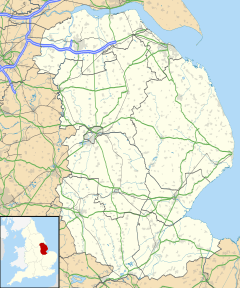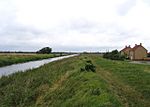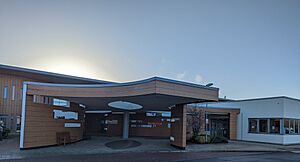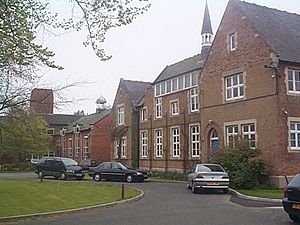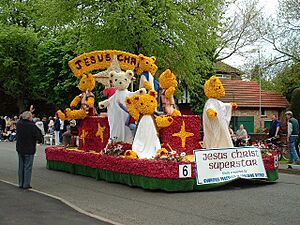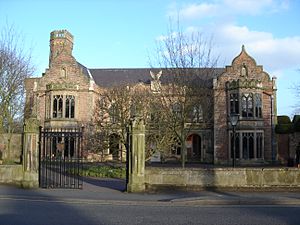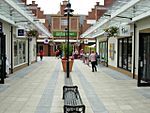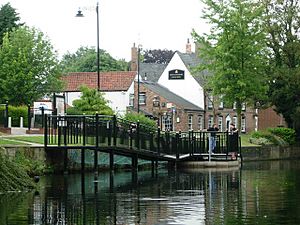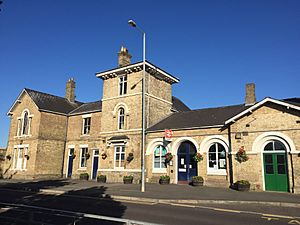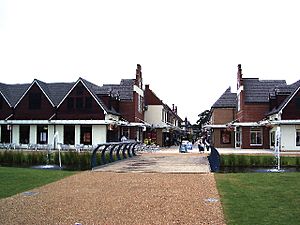Spalding, Lincolnshire facts for kids
Quick facts for kids Spalding |
|
|---|---|
 The River Welland passing through Spalding |
|
| Population | 30,556 (2021) |
| OS grid reference | TF245225 |
| • London | 90 mi (140 km) N |
| District | |
| Shire county | |
| Region | |
| Country | England |
| Sovereign state | United Kingdom |
| Post town | SPALDING |
| Postcode district | PE11, PE12 |
| Dialling code | 01775 |
| Police | Lincolnshire |
| Fire | Lincolnshire |
| Ambulance | East Midlands |
| EU Parliament | East Midlands |
| UK Parliament |
|

Spalding is a busy market town in Lincolnshire, England. It sits right on the River Welland. In 2021, about 30,556 people lived here. Spalding is the main town for the South Holland area. You can find it between the cities of Peterborough and Lincoln.
For many years, Spalding was famous for its annual Flower Parade. This parade, held from 1959 to 2013, showed off the huge number of tulips grown nearby. It also celebrated the special connection between the Fens area and the Netherlands. Over 100,000 people used to come to see it! Since 2002, the town has also held a fun pumpkin festival every October. In 2023, a new flower parade was started again by Steve Timewell and volunteers. Spalding also hosts the Spalding Festival.
Contents
People from Spalding
Some famous people have come from Spalding:
- Maurice Johnson (born 1688) started the Spalding Gentlemen's Society. He also helped create the Society of Antiquaries, which studies old things.
- Will Wand is a professional rugby player for Leicester Tigers.
Spalding's History
Early Times
Digs at Wygate Park in Spalding show that people have lived here since at least the Roman period. Back then, this part of Lincolnshire was used to make salt. It was a coastal area with lots of silt. Salt-making stopped around the mid-7th century BC. This might have been because of climate changes and floods.
The town's name comes from an old Anglian tribe called the Spaldingas. They settled in this area in the 6th century. They might have kept their own rules within the Kingdom of Mercia until the late 9th century. Then, Stamford became one of the Five Boroughs of the East Midlands. This happened after years of invasions by the Danes.
Domesday Book Entry
Spalding was mentioned in the Domesday Book of 1086. This was a big survey of England ordered by William the Conqueror. In 1086, Spalding had 91 households, which made it one of the larger settlements. It was owned by three different groups:
- The Abbey of Crowland (St Guthlac)
- Ivo Tallboys
- Guy of Craon
The Domesday Book also noted things like ploughland, plough teams, fisheries, and salthouses. It showed how much the land was worth each year.
Victorian Era Growth
In 1887, a book called Gazetteer of the British Isles described Spalding. It said Spalding was a market town with a railway station on the River Welland. It had a population of 9,260 people. The town had a post office, telegraph office, banks, and newspapers. Tuesday was market day.
Spalding was an important railway hub. The river was also made deep enough for boats carrying 50 to 70 tons. The town was in a rich farming area. It traded a lot of corn, wool, coal, and timber by river and rail. Spalding also had flour mills, sawmills, breweries, and places that made coaches. There were parts of an old priory from 1501, a beautiful old church, a grammar school, and a large market place.
The River Welland
Draining the Fens

The River Welland flows through Spalding, dividing the town from east to west. The town has grown up around the river. People have been reclaiming land from the wetlands here since the Middle Ages. Spalding used to flood often. But in 1953, the Coronation Channel was opened. This channel sends extra water around Spalding and stopped the flooding.
The areas along the river banks have been built up with homes and businesses. Even though there are many buildings, people still enjoy using the river for fun. Fishing is also still very popular here.
Water Taxi Fun
In July 2005, a "Spalding Water Taxi" service started. It runs from Easter until late October. The taxi goes from near Spalding's High Street, up the river, into the Coronation Channel, and then to Springfields Outlet Shopping & Festival Gardens. It's mainly used by tourists for fun trips.
Vernatt's Drain
To the northwest of Spalding, there's a large waterway called Vernatt's Drain. It's named after Philibert Vernatti, who helped drain the Fens in the 17th century.
A nature reserve run by the South Holland council is located on part of the old Boston railway line at Vernatt's Drain. The Drain flows from the pumping station at Pode Hole to Surfleet Seas End. Fulney Lock is where the Welland river stops being affected by tides. Spalding is part of the area managed by the Welland and Deepings Internal Drainage Board, which helps control water levels.
Population Information
The town, including the nearby village of Pinchbeck and the hamlet of Little London, had about 31,588 people in 2011. In 2020, the government estimated the population was around 36,737.
Healthcare in Spalding
The Johnson Hospital in Spalding is named after the Johnson family, who were important local figures. It used to be a casualty hospital. In 2000, the hospital moved to a new, modern building in the town. This new hospital, called "The Johnson Community Hospital," opened in 2009. It keeps the historical link to the Johnson family.
The Princess Royal officially opened the new hospital in January 2010. It brought many health services together in one place. The Johnson Hospital has 32 beds for patients, including a special area for palliative care. There are also two main doctor's surgeries in Spalding: Munro Medical Centre and Beechfield Medical Centre. Smaller surgeries are in nearby villages.
The closest big hospitals for serious medical care are the Pilgrim Hospital in Boston (18 miles north) and Peterborough City Hospital in Peterborough (22 miles south-west).
Education in Spalding
Primary Schools
Spalding has several primary schools for younger children:
- Ayscoughfee Hall - a private school near the river.
- Spalding Parish Church of England Day School - on Clay Lake.
- St John the Baptist School (Church of England) - on Hawthorn Bank.
- St Norbert's Roman Catholic Primary School - on Tollgate.
- Monkshouse Primary - on Pennygate.
- St Paul's Primary - on Queen's Road.
- Spalding Primary School - on Woolram Wygate.
- Wygate Park Academy - on Witham Road.
Secondary Schools
Spalding has different types of secondary schools:
- The Sir John Gleed School (for ages 11-16) was formed in 2012 by combining the Gleed Boys' School and Gleed Girls' Technology College. In 2016, it became Spalding Academy. After leaving, many students go to nearby sixth forms or colleges like Boston College or New College Stamford.
- The town also has state grammar schools, which select students based on an eleven-plus exam. These are Spalding Queen Elizabeth Royal Free Grammar School (for boys aged 11-16) and Spalding High School (for girls aged 11-16). Both schools have mixed sixth forms for older students (16-18).
There are also special schools for children with learning needs: the Priory School (for mild to moderate difficulties) and the Garth School (for more complex needs).
Sixth Form Options
A vocational sixth form was set up in 2008 as part of the Gleed Campus. This gave more options for students who didn't attend the grammar schools. Students from Gleed schools can also transfer to the Grammar and High schools for A-Levels.
Local Industry and Business
Flowers and Vegetables
Spalding is in the middle of a big area for growing flowers and vegetables. This is because of the rich, silty soil, which used to be marshland or river estuaries. You'll find many garden centres and plant nurseries here. There's also a busy farming industry and many places that pack vegetables.
The main vegetables grown are potatoes, peas, carrots, broccoli, spinach, lettuce, cabbage, kale, and Brussels sprouts. Most of these are sold to big supermarkets.
Spalding has a popular market every Tuesday and Saturday. On the first Saturday of each month, there's also a farmers market. A local shop called Booth's sells lots of local produce to the people of Spalding.
Tulip History
Spalding is known as The Heart of the Fens. It has long been famous for its bulb industry, especially tulips. The town has strong ties with the Netherlands, where the Geest family (who were once major local employers) came from.
The annual Tulip Parade used to happen on the first Saturday in May, starting in 1959. It was a huge tourist event. The parade had floats decorated with tulip petals, which were a leftover from the bulb industry. If the tulips were late, daffodils or hyacinths were sometimes used. If they were early, crepe paper was used instead.
The flower industry has become less important since the early 2000s. The bright fields of tulips that used to cover the fenland have become much smaller. At its best, the Parade brought in over 100,000 visitors. But by 2012, fewer than 40,000 attended. Because of this, the local councils decided not to fund the parade after 2013.
Spalding was chosen to host the World Tulip Summit in 2008. This was part of a bigger "Tulipmania" festival that happened at the same time as the 50th Flower Parade. The Spalding Tulip Parade was brought back in 2023 by Stephen Timewell and many volunteers, funded by people donating money.
Main Companies in Spalding
Spalding is home to several important companies:
- FESA UK Ltd: This company imports and packs fresh produce. They are part of a Spanish group and have been in Spalding since the late 1980s. They employ many local people at their large facility.
- Greencore: This factory makes prepared salads. It used to be called Unigate and Uniq Plc.
- Fowler-Welch: This transport company has its UK base in Spalding. It was bought by the Dart Group in 1994 and then sold to Culina Group in 2020.
- Bakkavör: This company bought Geest, a major Spalding-based company, for £485 million. Geest started in 1935 by John and Leonard van Geest, who imported tulip bulbs. A salad factory opened in Spalding in 1972. In 2010, Bakkavör moved its main offices to Spalding.
- EMAP: This publishing company, now mostly based in Peterborough, was started by Sir Richard Winfrey in Spalding. He bought the Spalding Guardian newspaper in 1887.
- Welland Power Diesel Generators: They make and build Perkins-powered diesel generators for export.
- Lloyd Loom of Spalding: This company makes traditional handmade British furniture.
- Melon&Co Ltd: This is the UK branch of a Brazilian company called Agricola Famosa. It was set up in 2021.
- Paragon Print & Packaging: This company designs food packaging.
- Spalding Power Station: A large gas-fired power station was opened in Spalding in 2004. It cost £425 million. A second part of the power station opened in 2019. There are also plans to build one of the world's largest battery energy storage systems next to it.
Landmarks and Facilities
Historic Buildings to See
Ayscoughfee Hall is a very old building from the 15th century. It is now a museum that you can visit.
Spalding Parish Church, also known as St Mary and St Nicolas, was built in 1284. The tall tower and spire were added in 1360.
The Church of St John the Baptist was built in 1875, along with the school next to it. St Paul's Church in Fulney, on the east side of town, was designed by Sir George Gilbert Scott and finished in 1880.
Other interesting places to visit nearby include the Pinchbeck Engine Museum, the Bulb Museum, and the Gordon Boswell Romany Museum. The Chain Bridge Forge is a 19th-century blacksmith's forge by the River Welland. Many of its original parts are still there, and it's now a museum. The Chatterton Tower is also a well-known landmark.
Spalding War Memorial
The Spalding War Memorial is in the gardens of Ayscoughfee Hall. It remembers the 224 men from the town who died in the First World War. It was designed by Sir Edwin Lutyens, who also designed the Cenotaph in London. The memorial has a pavilion and a Stone of Remembrance at the end of a long pool. The names of the fallen soldiers are carved on the back wall of the pavilion.
Shopping and Entertainment
Spalding has several supermarkets, including Sainsbury's, Lidl, and Aldi in the town centre, and a Morrisons in Pinchbeck. Outside the town, Springfields Outlet Shopping & Leisure offers many outlet stores. These are set in beautiful gardens designed by famous gardeners like Charlie Dimmock.
The Castle Sports Complex has fitness facilities for everyone. The South Holland Centre is an arts centre where you can watch concerts, theatre shows, and films.
History of the Barcode
Did you know that the first barcode used at a shopping till in the UK was in Spalding? It happened on 7 October 1979, at Key Markets.
Power Stations and Wind Farms
The new £425 million, 860 MW combined cycle gas turbine Spalding Power Station was built in 2004. It is located on West Marsh Road. A second part of the power station, adding 300 MW, opened in 2019. There are also plans to build a huge battery energy storage system next to the power station.
In 2006, a new wind farm in nearby Deeping St Nicholas became visible from much of Spalding.
Sports in Spalding
Spalding has several sports teams:
- The local football team is Spalding United. They play in the Northern Premier League Division One Midlands.
- The local rugby team is Spalding RFC. They play in the Midland Division - Midlands 3 South at Memorial Field.
- The local cricket team is Spalding Town Cricket Club. They have several teams that play in different leagues.
- The local hockey club is Spalding HC. Their men's and women's teams play in the East Division Premier Division.
Getting Around Spalding
Road Travel
Spalding, like Boston, is a common stop for large trucks carrying processed vegetables and other food. The A16 used to go through the town. But in 1995, a new bypass was opened, which helped reduce traffic. A new road, also called the A16, now connects Spalding to Eye Green in Peterborough.
The town has its own bus station, Spalding bus station.
Train Travel
Spalding railway station is on the Lincoln Central - Peterborough railway line. Trains are run by East Midlands Railway. The service is not very frequent and doesn't run at night or on Sundays. However, it's useful for getting to Peterborough for work or shopping.
In 2002, a main-line diesel train was named after Spalding. It was called 'Spalding Town' and its nameplates were shown at the station.
Media in Spalding
Television
Local news and TV shows for Spalding come from BBC Yorkshire and Lincolnshire and ITV Yorkshire. You can also sometimes get BBC East Midlands and ITV Central.
Radio
The town is served by BBC Radio Cambridgeshire and BBC Radio Lincolnshire. Other radio stations include Smooth East Midlands, Greatest Hits Radio Lincolnshire, and Hits Radio Lincolnshire. Spalding used to have its own community radio station called Tulip Radio, which broadcast from 2009 to 2017.
Newspapers
Spalding has several local newspapers: the Spalding Guardian, Lincolnshire Free Press, Spalding Today, and Spalding Voice.
Spalding Timeline
- 750 BC - AD 410: People lived in the Spalding area during the Iron Age, Roman, and Medieval periods.
- 1015: A Benedictine Priory (a type of monastery) was started.
- 1086: The town is recorded in the Domesday Book as 'Spallinge'.
- 1284 (around): St Mary and St Nicolas, Spalding church was built.
- 1377: The White Hart Inn in the Market Place was built.
- 1430s: Ayscoughfee Hall was built.
- 1566: Mary, Queen of Scots, stayed overnight at the White Hart Inn.
- 1588: The Spalding Grammar School was founded.
- 1590s: Spalding's first drains were built to manage water.
- 1650: Sir John Gamlyn started almshouses (homes for poor people) in Spalding.
- 1688: Maurice Johnson was born at Ayscoughfee Hall.
- 1710: Maurice Johnson founded the Spalding Gentlemen's Society Museum, which is the second-oldest museum in the country.
- 1767: Jean-Jacques Rousseau, a famous philosopher, stayed at the White Hart Inn.
- 1768: Holland House, a beautiful home, was built.
- 1774: Matthew Flinders, who was the first person to sail around Australia, was born nearby.
- 1801: The population of Spalding was 3,296.
- 1805: The Friends Meeting House was built.
- 1826: Spalding's last house of correction (a type of prison) was built. It closed in 1884.
- 1831: The population of Spalding was 6,497.

- 1838: The High Bridge over the River Welland was rebuilt.
- 1842: The Sessions House was built.
- 1847: The Spalding Free Press newspaper was started.
- 1848: The Great Northern Railway opened its station in Spalding.
- 1851: The population of Spalding was 8,829.
- 1852: William Bramwell Booth, who founded the Salvation Army, worked in Spalding.
- 1854: Spalding Cemetery was officially opened.
- 1855-56: The Corn Exchange was built.
- 1857: The Butter Market was opened.
- 1858: The police station was built.
- 1860: A law was passed to bring fresh water to Spalding from Bourne.
- 1866-67: St Mary and St Nicolas, Spalding church was greatly restored.
- 1870: Goodfellows National School was opened.
- 1871: The population of Spalding was 9,111.
- 1874: The church area of St. John the Baptist was created.
- 1875: The Church of St John the Baptist and its primary school were built.
- 1875-76: The Church of St. Peter was built on the site of the old Abbey.
- 1878: Spalding's Roman Catholic church was built.
- 1878: Frank Pick, who designed the modern look of the London Underground, was born.
- 1880: St Paul's Church in Fulney was built.
- 1881: The current grammar school building was put up.
- 1884: Spalding's last house of correction closed. The library is now on part of that site.
- 1887: The Methodist church was opened.
- 1891: The population of Spalding was 9,014.
- 1916: Spalding Arts and Crafts Society was founded for soldiers recovering from injuries in World War I.
- 1921: Spalding United F.C. (football club) was formed.
- 1923: Spalding RFC (rugby club) was formed.
- 1941: During World War II, a German bomber dropped bombs on Spalding, destroying parts of Hall Place and killing 5 people.
- 1958: The first Spalding Flower Parade took place.
- 1959: The M&GN railway closed, ending direct train services to Great Yarmouth.
- 1960: St Nicolas Players Amateur Dramatic Society was formed.
- 1965: Spalding and District Amateur Radio Society was formed.
- 1967: The "Barbeque 67" music festival took place, with famous bands like Jimi Hendrix Experience and Pink Floyd.
- 1970: The East Lincolnshire railway line closed, ending direct train services to Boston and London.
- 1974: Spalding became part of the new South Holland council.
- 1977: Parts of the BBC TV series Murder Most English were filmed in Spalding.
- 1982: The GN&GE 'Joint Line' railway to March closed.
- 2001: The population of Spalding was 25,780.
- 2002: A main line train was named 'Spalding Town' at the station.
- 2004: A new gas-fired Spalding Power Station opened.
- 2004: Springfields Outlet Centre opened in May.
- 2008: Tulip Radio was given a full broadcasting licence. It broadcast from 2009 until 2017.
- 2009: The Johnson Community Hospital, a nurse-led hospital, opened.
- 2011: The population of Spalding was 31,588.
- 2016: The first Spalding Festival, a community beer and music festival, was held.
- 2020: Spalding Railway Station finished a big £2.5 million upgrade, adding lifts for easier access.
- 2021: The population of Spalding was estimated to be 36,737.
- 2021: Spalding’s Urgent Treatment Centre (UTC) opened at the Johnson Community Hospital.
- 2023: Ayscoughfee Hall and gardens had a £375,000 upgrade.
- 2023: Spalding's Castle Sports Centre received £25 million from the government.
|
See also
 In Spanish: Spalding (Lincolnshire) para niños
In Spanish: Spalding (Lincolnshire) para niños


